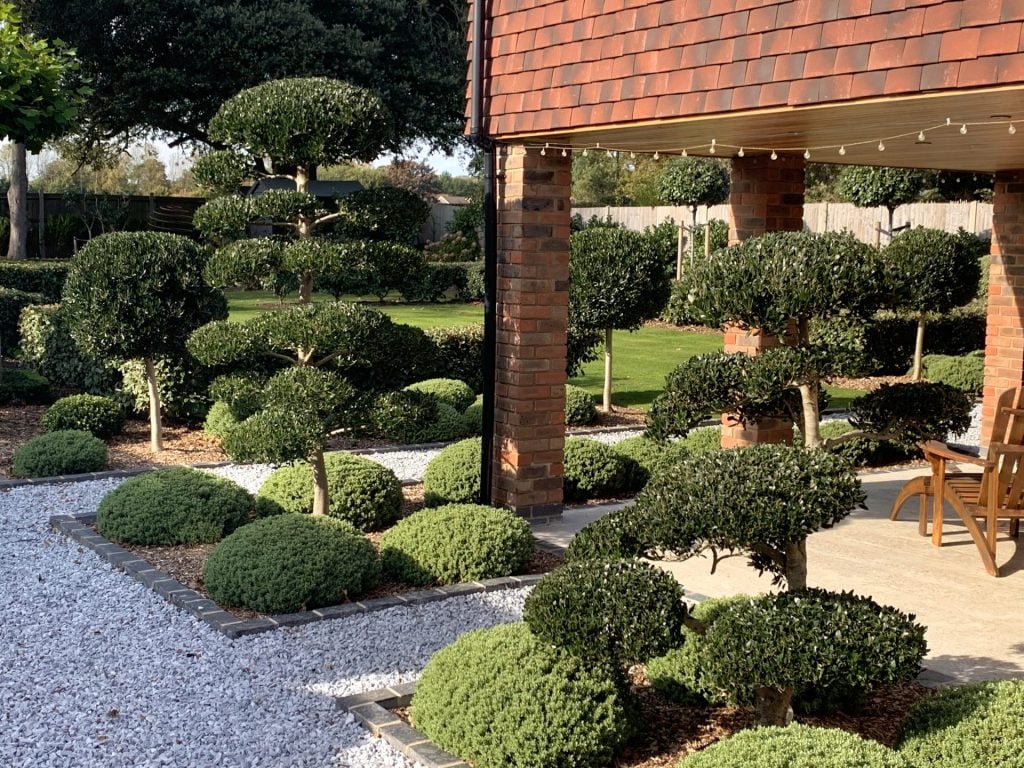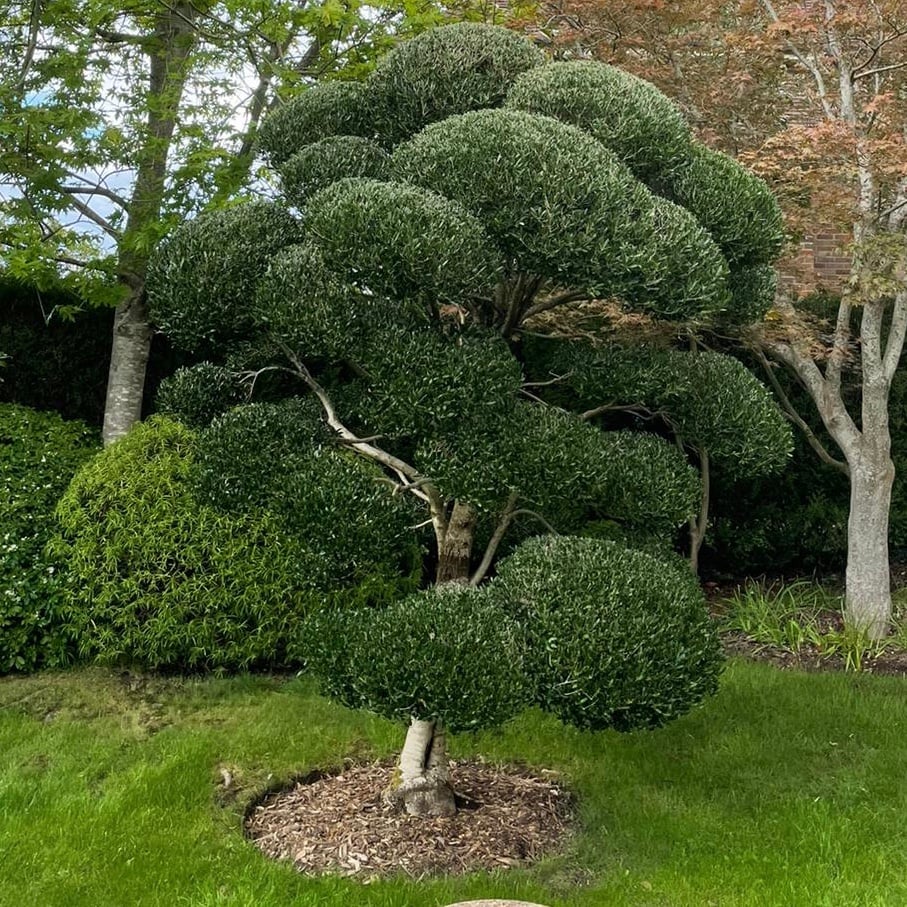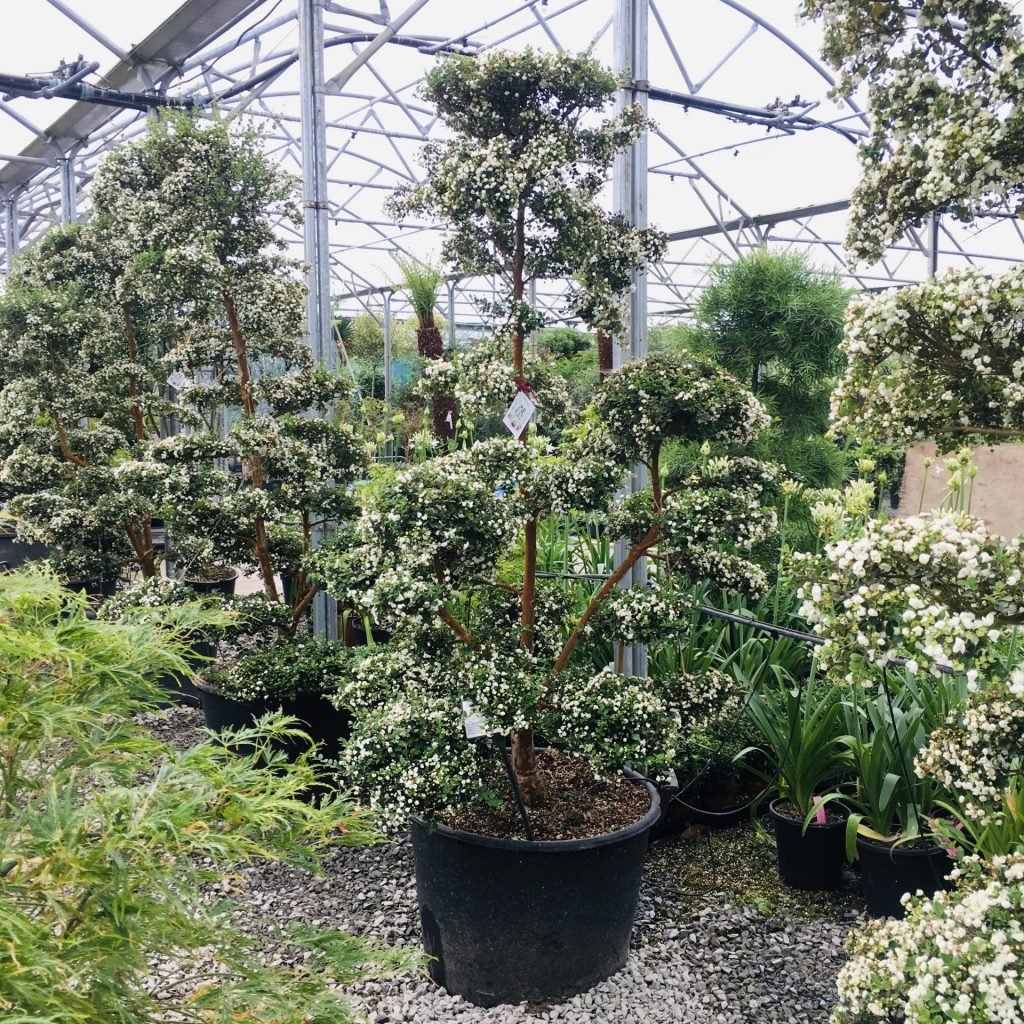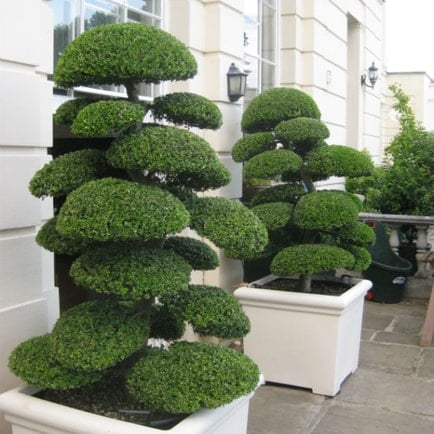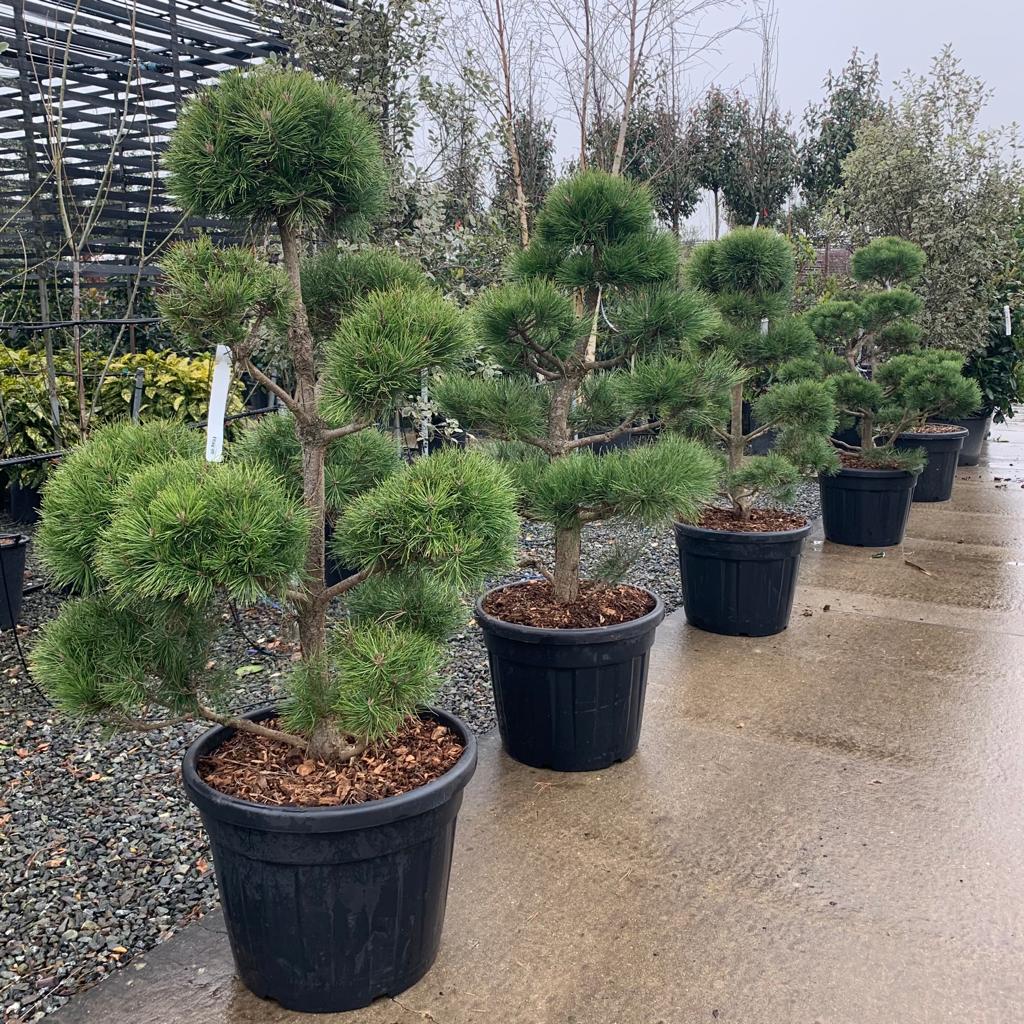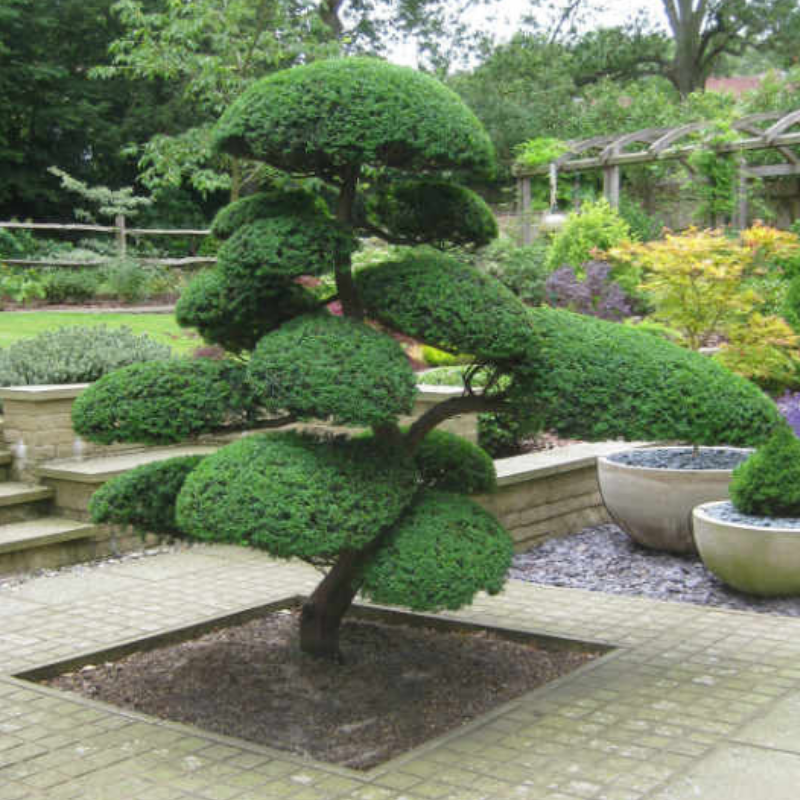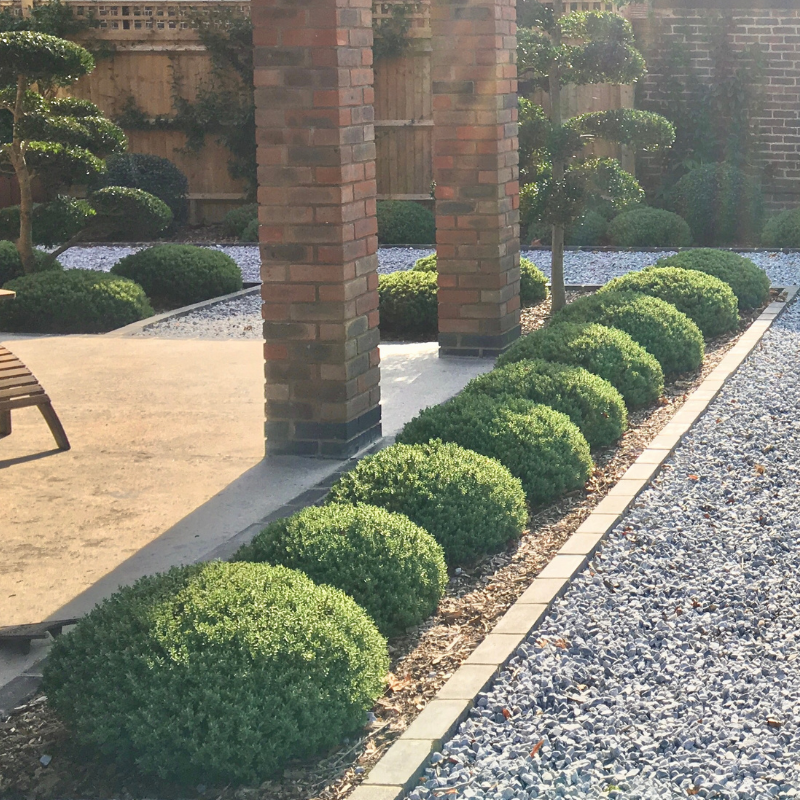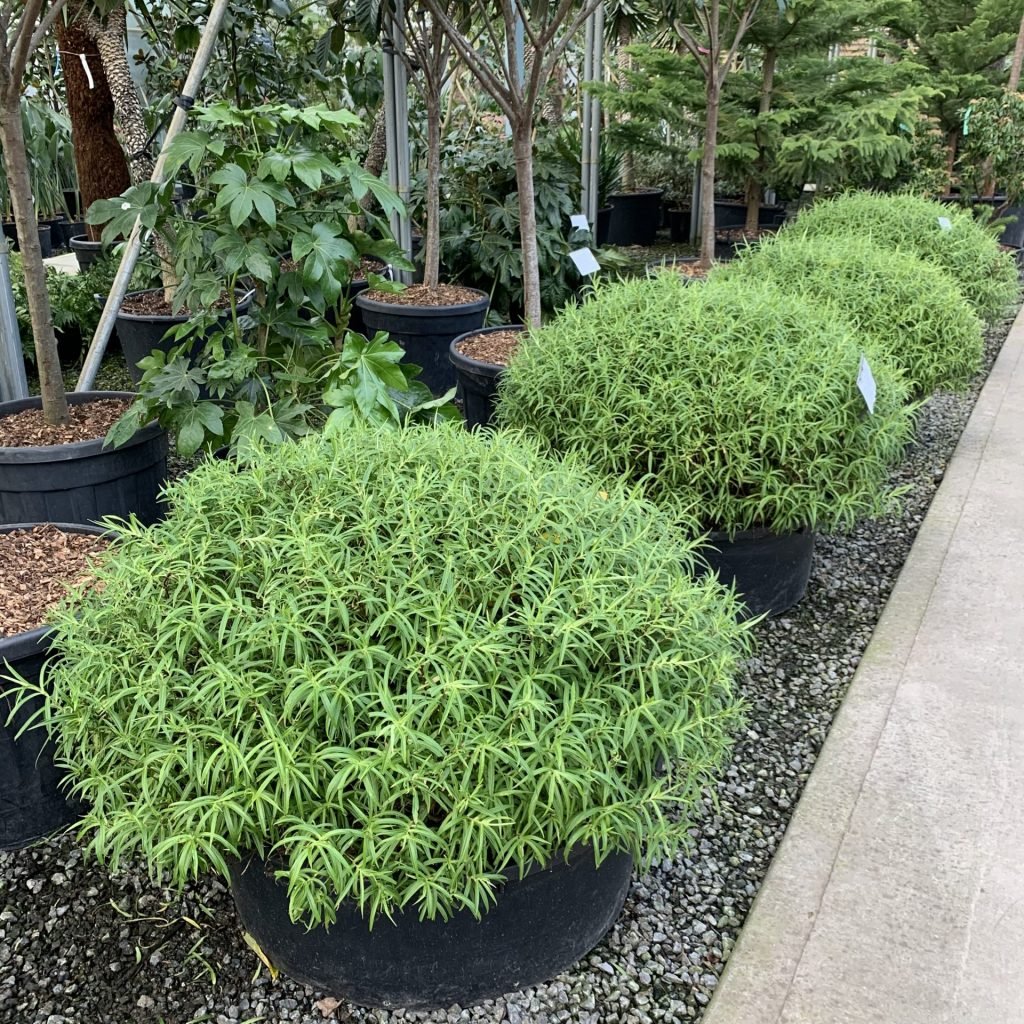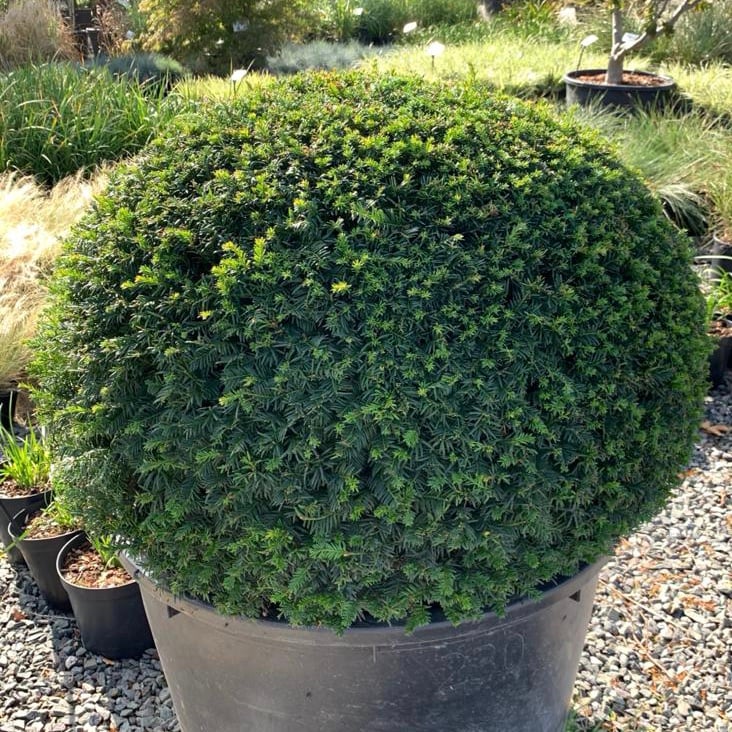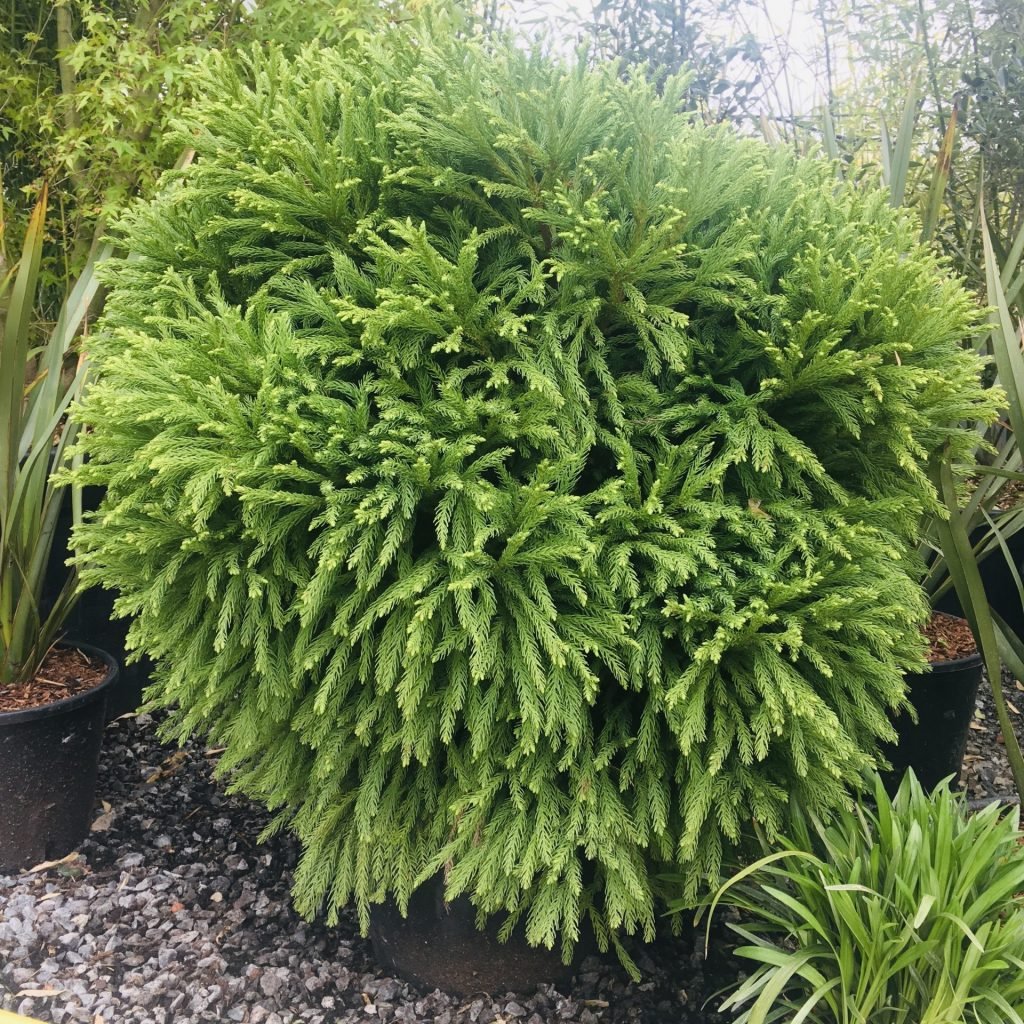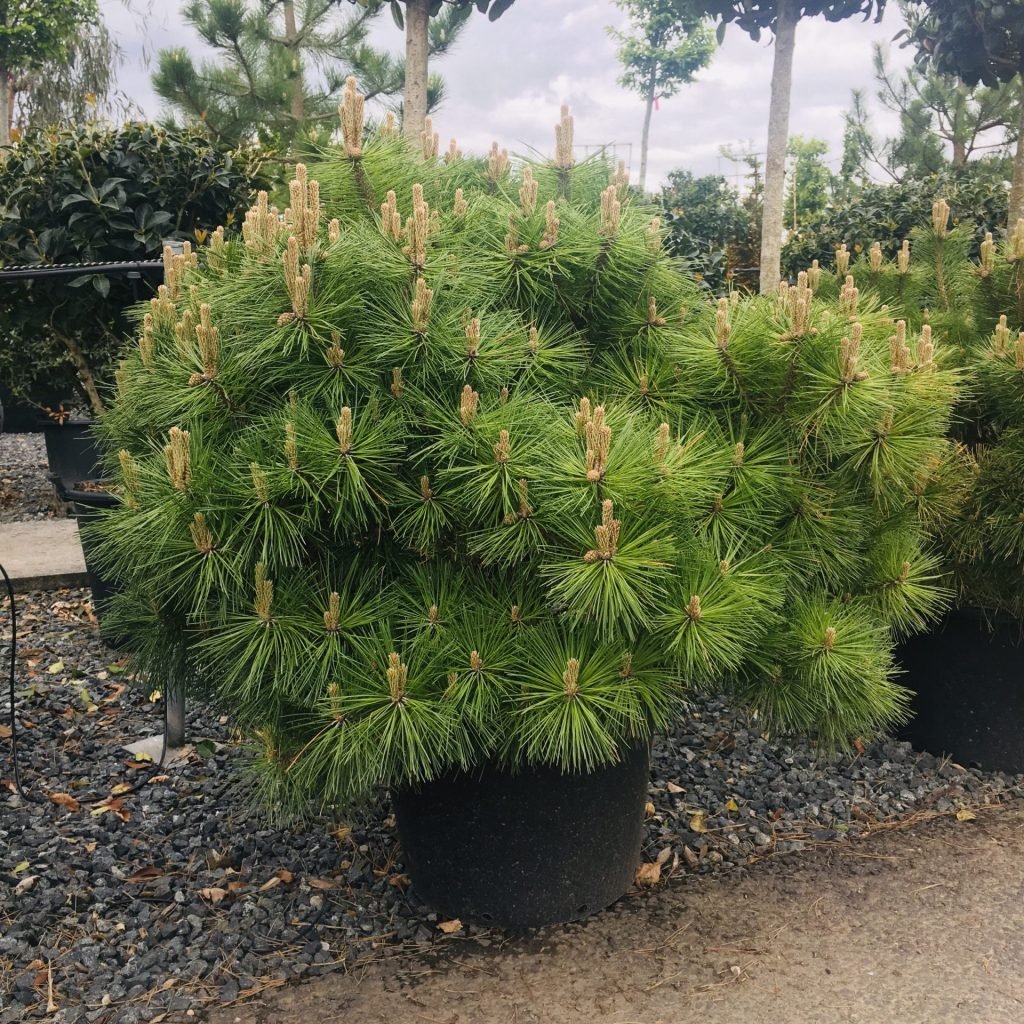
Japanese Garden Design
Niwaki, Topiary, Acers, Blobberies and Bamboo
Japanese Garden Design
Our Concept of fusion
Our concept of a Japanese Garden Design is a fusion of form, texture, colour and contrast. We like to bring together plants which are intrinsically synonymous with Japanese aesthetics and plants which are most definitely not, but do by their habit and shaping (topiarising), compliment each other brilliantly. We set the foundations of a design with bold and sculptural cloud pruned ‘Niwaki’ (predominantly evergreen). We favour the use of space in a design to frame and create presence and to emphasise their architecture and often asymmetrical character.
From here we begin to consider accompanying forms – either complimentary or contrasting. Topiarised or just gently teased shapes, blobs and pillows can be loose and fluffy or smaller leafed for a more compact and crisp shape. It is here where the idea of fusion really begins to take off. Think loose and fluffy for texture and movement and think compact and clipped for formal gravitas and defined framing. From whichever continent they come from, used both in a minimal and considered way they are excellent for filling space subtly and helping to direct the eye through a design.
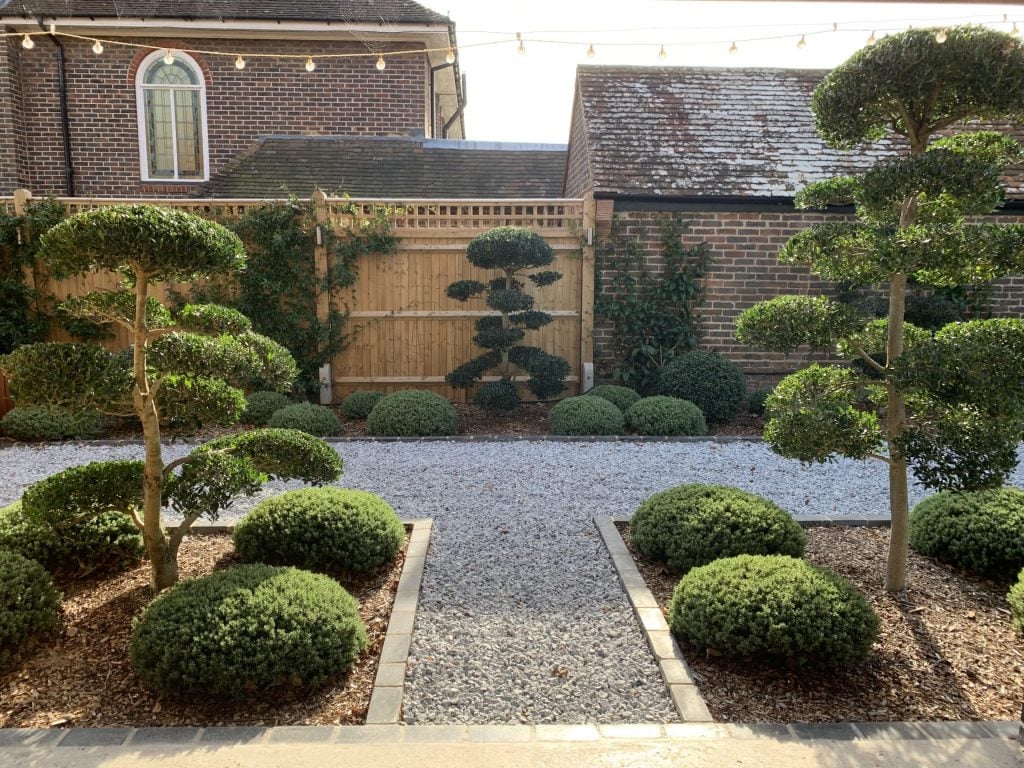
Our Designer
AMY

Amy Robertson is our award-winning garden designer, winning a Silver-Gilt and People’s Choice Award for a garden she designed with two fellow designers at RHS Hampton Court Palace Flower Show in 2015.
Amy is an experienced garden designer and horticulturalist, with over 12 years in the industry. She trained at Brinsbury College before working with the Garden Team at Nymans National Trust. Amy went on to establish her own successful garden design and maintenance business before joining the growing Architectural Plants team in February 2017.
Amy graduated from the Garden Design School in 2013 and has since worked on a variety of projects from courtyard gardens to large country gardens.
Amy’s featured design here uses Phillyrea latifolia ‘Niwaki’ and topiarised half standards, Myrtus apiculata ‘Niwaki’ and Hebe sutherlandii pillows.
We can’t tell you how delighted we both are with our fabulous planting scheme – you’ve given us our dream garden. I just had to message you tonight to let you know we are thrilled”
Evergreen Niwaki & Topiary
Amy’s featured design of ‘Niwaki’ and Topiary leads you through a structured courtyard of defined angles offset by the asymmetry and softness of our homegrown and cloud pruned Phillyrea latifolia, Myrtus apiculata and topiarised Hebe sutherlandii pillows.
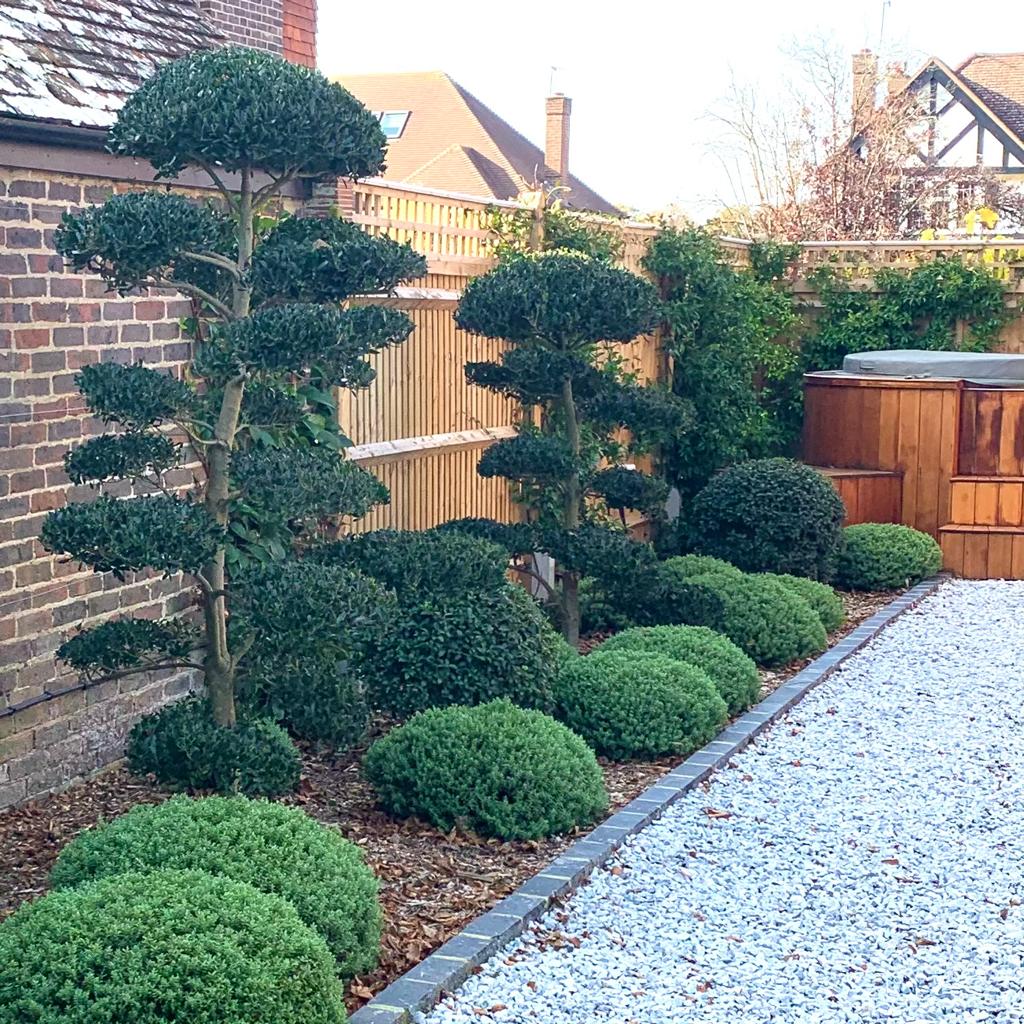
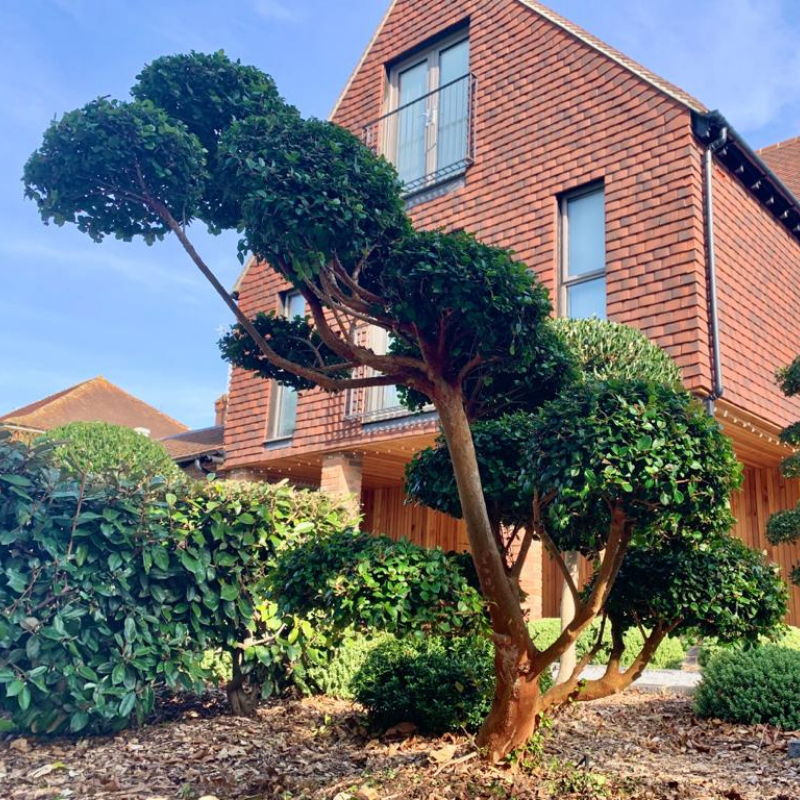
Our homegrown favourites include, Phillyrea latifolia, Myrtus apiculata and Podocarpus salignus. Other ‘Niwaki’ with equal architectural verdancey which we love are Ilex crenata, Taxus cuspidata and Pinus sylvestris.
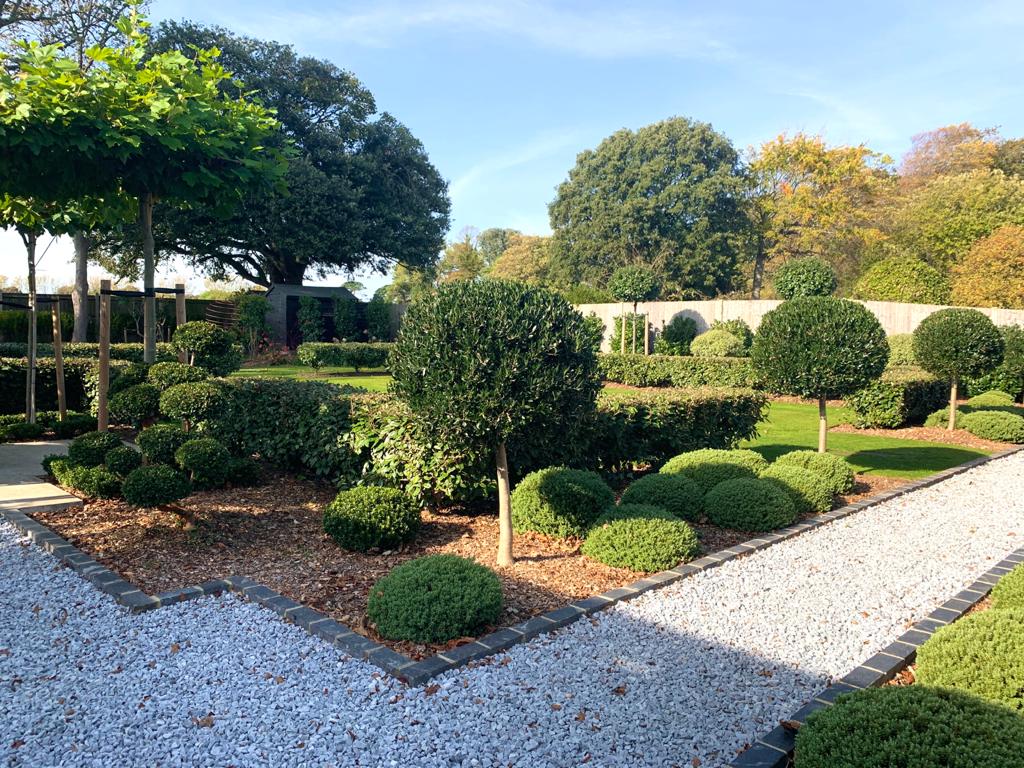
What does Niwaki mean?
What exactly does ‘Niwaki’ mean? It’s Japanese for ‘garden tree’. Bonsai is Japanese for ‘pot plant. the implication is obvious. Niwaki are meant to go in the ground. However, positioned correctly with the right protection and irrigated properly we know that some are very happy and look fantastic in pots and planters – perfect for a Japanese styled courtyard. For Niwaki that look the business in a pot you might like Ilex crenata or Taxus cuspidata.
Our Favourite Niwaki For Japanese Gardens
Phillyrea latifolia
Phillyrea latifolia ‘Niwaki’ has beautifully dense foliage producing incredibly tactile extra glossy new growth. It’s incredibly tough and can be grown anywhere with adequate light. They are very good for larger gardens or more exposed sites as well as more protected, urban gardens and courtyards. Grown, trained and shaped by us.
Myrtus apiculata
Myrtus apiculata ‘Niwaki’ has beautiful red bark and fragrant white flowers in early summer. It’s tolerant of sun or shade but very intolerant of dry conditions. It requires plenty of moisture to grow. It also needs shelter from cold winds. Grown, trained and shaped by us.
Ilex crenata
Ilex crenata ‘Niwaki’ (Japanese Holly) has a compact little leaf that makes elegant, defined pads or ‘clouds’. They will produce flowers in the summer followed by small fruits. It is a reliable evergreen but it must be planted or kept (if it’s in a pot) in a sunny spot away from strong winds. If kept in a pot it must be kept moist. Feed with a slow release fertiliser.
Pinus sylvestris
Pinus sylvestris ‘Niwaki’ is a very different and exciting approach to the familiar Scots Pine. Years of skilful husbandry and training have helped to create this Japanese version of a very British tree. With glaucous needles it’s a fantastically textural from. Best planted in the ground with plenty of light and well-drained soil.
Taxus cuspidata
Taxus cuspidata ‘Niwaki’ is a yew native to Japan. It has a reputation for being slow growing – it’s certainly long lived. Some Niwaki are at least 70 years old. The new growth is a dazzling fresh and vibrant green and it’s condensed leaf make it perfect for defined sculptural clipping.
Suitable Evergreen Plants For Japanese Gardens
Hebe sutherlandii
Hebe sutherlandii are perfect for keeping neat, compact and rounded. The small grey-green oval leaves contrast well with darker foliage. They produce lots of little white flowers in the summer adding a soft but formal addition to a design. They’re incredibly reliable but need light and well-drained soil.
Hebe paviflora ‘angustifolia’
Hebe paviflora ‘angustifolia’ is the perfect fluffy clipped pillow and fantastically tactile. It has a delicate long leaf of emerald green that will last all through the winter. In mid summer, it naturally produces a copious crop of white flowers. Extremely frost hardy and will grow absolutely anywhere.
Taxus baccata
Taxus baccata (Yew) look eminently ‘posh’ clipped as balls, blobs and cones. A native European plant, it has been a stalwart of formal gardens for centuries. With this heritage, and Their compact and solid habit allows you to give them crisp lines and defined they can add….Grows in light shade or sun but needs reasonably good drainage.
Cryptomeria japonica ‘Globosa Nana’
Cryptomeria japonica ‘Globosa Nana’ is an obscure variant of a large Japanese conifer. Fluffy, dense, globe shaped and wonderfully textured. They also bring subtle movement to a design when caught by the breeze. Raising the stem base adds further definition. Trim in the spring and plant in good organic and water retentive soil.
Pinus nigra ‘Marie Bregeon’
Pinus nigra ‘Marie Bregeon’ brings texture and presence to a design with bright candles which can appear almost white in the summer sun. Earlier in the year it develops beautiful glaucous-purplish cones. Quite a character – and one of a range of other dwarf pines we also love: Pinus ‘Mugo Mugo’ and Pinus ‘Brepo’
clipping tips & advice
As with all topiary, the more often you clip the plant, the thicker the foliage and the higher the definition. When clipping, have a bucket of dilute bleach (a spoonful in a bucket) by your side. every few minutes stick your shears or secateurs in the bucket. The bleach will kill fungal spores which otherwise you might be spreading on the tool from one plant to another.
This practice is compulsory on the nursery and for our Creative Maintenance Team, Andy and Sam. If you don’t want to worry about doing the clipping yourself our Team re ready to do the work for you.
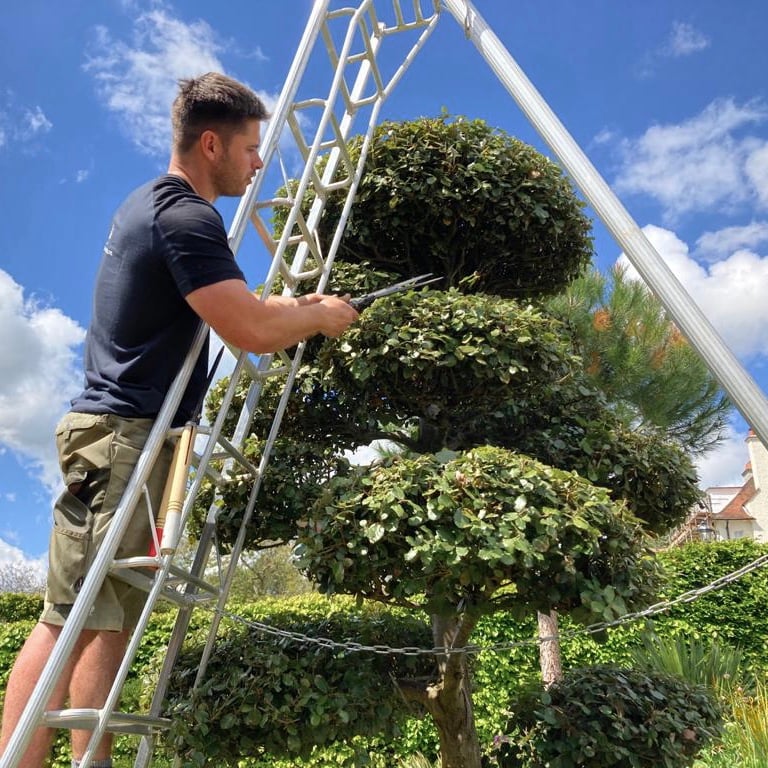
The Garden Design Process
Before going any further, here’s a good opportunity to emphasise the nature of the kind of gardens we do. In terms of size, we can design anything from courtyards and city roof terraces, to country homes and estate gardens; no job is too big or small. It could be formal or it could be exotic, but within that spectrum the emphasis will always be on the sculptural: strong, eye-catching shapes, beautiful textures and bold use of plants. It’s all to do with shape, shade, texture and definition – it’s not just about colour. Trying to have an engaging conversation with our owner, Guy, about overly colourful herbaceous borders could be an unrewarding experience; however, get him on avenues, pleached hedges, groves, striking acers, outrageous topiary and serious jungles and things could get interesting. In short, we only use our plants, so if you like the nursery, you’ll like your garden.
We rarely use drawings. The process is organic and customer-centred, with a hands on approach that ensures you’re a part of the journey from start to finish. Below is an outline of the design process.
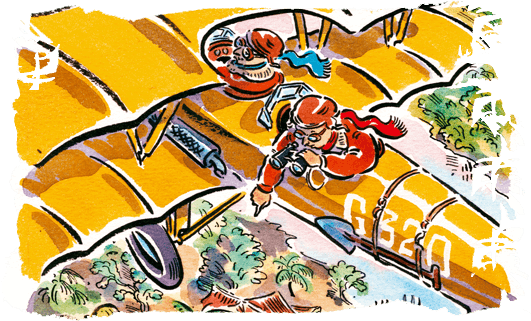
Before
1. You discuss your ideas with one of the sales team.
2. Our Design Manager, Debbie, will put you in touch with one of the designers.
3. They will visit you for a modest fee, based on their time (including travel).
4. A proposal follows, including a summary of your meeting, plant suggestions and the total cost of the plants, planting and irrigation (where applicable).
5. At this point we will invite you to the nursery to go through the design in greater detail and show you the actual plants that we will be using.
6. If you agree, a planting date is set, the plants are selected and you’re invoiced (just for the plants at this stage).

During
7. The designer and planting team will arrive on the specified day and the plants will be positioned – a bit like designing on the ground, instead of on a piece of paper.
8. Once you’re happy with the arrangement, the beds will be reshaped where necessary and the planting will begin.
9. Once planted, an irrigation system is installed (this is optional, but we always recommend it), new edges are cut, mulch is applied and everything is left looking lovely.
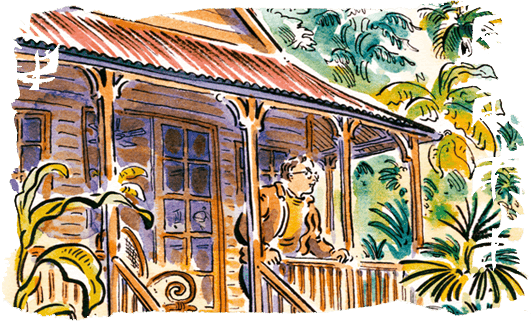
After
10. You’re invoiced for the planting, irrigation system, mulch, etc., and left in peace to enjoy your garden.
11. We remind you that it doesn’t necessarily end there: creative maintenance, plant advice and horticultural expansion are all right up our street.

